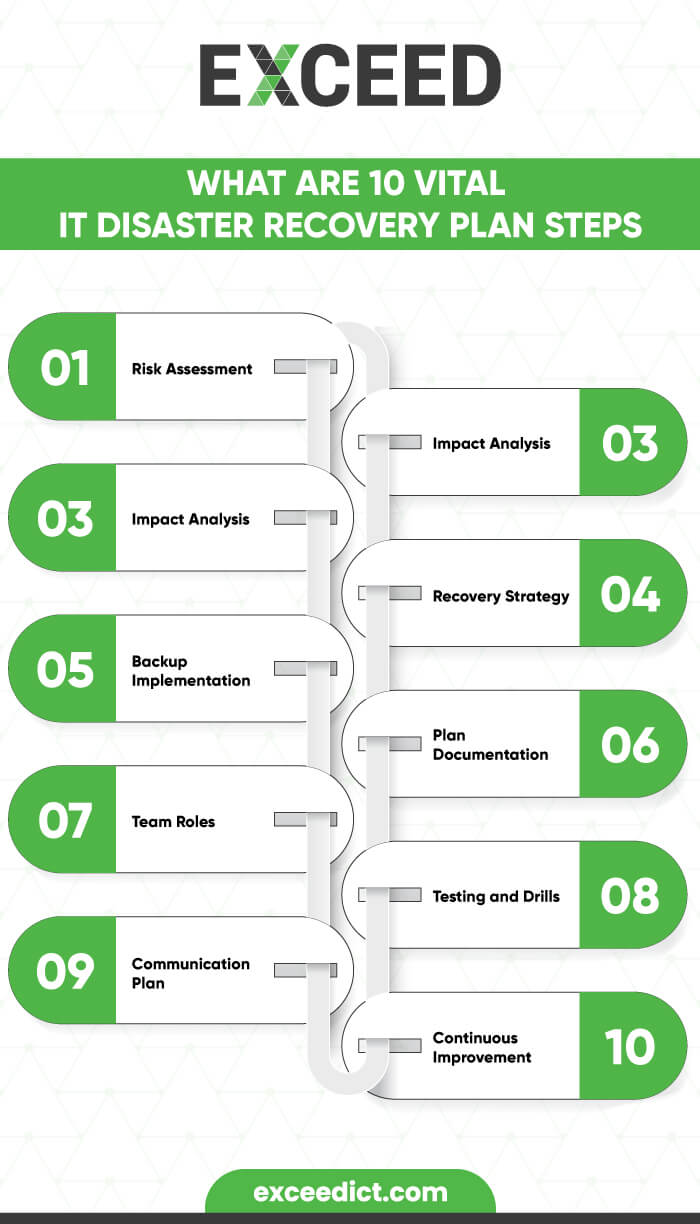
IT Disaster Recovery Plan Steps
 In the modern digital landscape, where businesses heavily rely on technology, having a robust IT disaster recovery plan is not just a luxury but a necessity.
In the modern digital landscape, where businesses heavily rely on technology, having a robust IT disaster recovery plan is not just a luxury but a necessity.
Unforeseen events such as natural disasters, cyberattacks, or hardware failures can disrupt business operations and lead to data loss, which can be catastrophic.
By following a comprehensive IT disaster recovery plan, businesses can minimise downtime, safeguard crucial data, and ensure business continuity.
In this article, we’ll explore the 10 essential steps that constitute an effective IT disaster recovery plan, helping you protect your business against the unexpected.
10 Vital IT Disaster Recovery Plan Steps

1. It Disaster Recovery Plan Steps – Understanding the Basics
Before diving into the specifics, let’s grasp the foundational concepts of an IT disaster recovery plan. This plan outlines the strategies, processes, and procedures a company follows to recover its IT systems and data after a disruptive event.
2. Evaluating Potential Risks
Identifying potential risks is the first crucial step in creating an effective disaster recovery plan. These risks could include natural disasters, cyber threats, hardware failures, and more. Conduct a thorough risk assessment to understand the vulnerabilities your business faces.
3. Creating a Recovery Team
Forming a dedicated recovery team is essential. This team should consist of individuals with expertise in IT, operations, communications, and management. Assign clear roles and responsibilities to each member to ensure a coordinated response.
4. Conducting Regular Data Backups
Backing up your critical data at regular intervals is paramount. Utilise both on-site and off-site backup solutions to ensure redundancy. Implement automated backup systems to minimise the risk of data loss.
5. Developing a Communication Strategy
During a crisis, effective communication is key. Establish a communication plan that outlines how to inform stakeholders, employees, customers, and the public about the situation. Keep contact lists updated and designate spokespersons for consistent messaging.
Establishing Recovery Time Objectives and Recovery Point Objectives. (RTO and RPO).
RTO defines the maximum acceptable downtime, while RPO defines the maximum data loss a company can tolerate. Balancing these objectives is crucial to determine the speed and depth of your recovery efforts.
6. Testing the Plan Regularly
A plan that’s never tested might not work when you need it most. Regularly simulate various disaster scenarios to evaluate the plan’s effectiveness. Adjust and improve the plan based on test results.
7. Training Employees
Educate your employees about the disaster recovery plan and their roles during an emergency. Conduct training sessions to ensure everyone knows how to respond and contribute to the recovery process.
8. Collaborating with External Partners
In some cases, external partners, such as vendors or service providers, might be involved in the recovery process. Establish clear lines of communication and coordination to ensure a seamless recovery.
9. Securing Critical Infrastructure
Protecting your critical IT infrastructure is vital. Implement cybersecurity measures to prevent cyberattacks and data breaches. Regularly update software, use firewalls, and employ encryption techniques.
10. Continuous Monitoring and Improvement
Disaster recovery is an ongoing process. Continuously monitor and assess the effectiveness of your plan. Incorporate lessons learned from real incidents and stay updated with evolving technologies.
Frequently Asked Questions
What is an IT disaster recovery plan?

An IT disaster recovery plan is a comprehensive strategy that outlines how a business will recover its IT systems and data after a disruptive event, ensuring continuity and minimising downtime.
How often should I update my disaster recovery plan?
Your disaster recovery plan should be reviewed and updated at least annually or whenever there are significant changes in your business infrastructure or operations.
What is the role of a recovery team?
A recovery team is responsible for executing the disaster recovery plan, coordinating efforts, and ensuring a swift and effective response to disruptive events.
What advantages can a small business gain from having a disaster recovery plan?
Absolutely. Small businesses are just as vulnerable to disruptions as larger ones. Having a disaster recovery plan tailored to your business’s needs can save you from significant losses.
How can I ensure my employees understand their roles?
Regular training sessions and drills can help familiarise employees with their roles and responsibilities during a disaster. This preparation can lead to a more coordinated response.
Is off-site data backup necessary?
Yes, off-site data backup provides an additional layer of security. It ensures that even if your primary location is compromised, your data remains safe and recoverable.
In today’s unpredictable business landscape, having a well-defined IT disaster recovery plan is no longer optional – it’s a necessity. By following the 10 essential steps outlined above, businesses can fortify their operations against unforeseen events, protect their data, and ensure seamless continuity.
Remember, preparation is the key to effectively navigating through disruptions and emerging stronger on the other side.
You may also like to know more about
- Disaster Recovery Plan For Ensuring Business Continuity in Challenging Times.
- Business Continuity Planning vs Disaster Recovery Planning.
- Step by Step Guide for a business continuity plan.
- What is Business Continuity Planning? Importance, Risk Assessment, & Core Objectives.
- Understanding the Disaster Recovery Planning – steps, benefits and best practices.
- Disaster Recovery Planning To Ensure The Connectivity in Crisis.
Stay connected with EXCEED ICT
Stay connected with EXCEED ICT by joining our social networks (given at footer). Get the latest updates, news, and tips for enterprise device deployment. Follow us on Twitter, Facebook, and LinkedIn for the best enterprise device deployment solutions.
Help us to improve our enterprise by rating us on Google Maps. Your feedback and comments are valuable to us and will be used to make our services even better.


